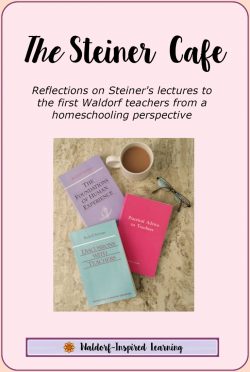It’s a Q&A day with Rudolf Steiner at the very first Waldorf teacher training in 1919. A Wednesday afternoon at the Teacher’s Seminar, when the teachers-in-training ask questions and Steiner offers his comments. Steiner wants teachers to remember to create lively lessons.
Steiner has two main points today:
1. Think of creative ways to help the child understand the concept, and
2. Keep the lessons lively.
Make it as lively as possible!
 This particular discussion that we’re reflecting on here took place on September 3, 1919; it’s Discussion Twelve (out of fifteen). And it was a short day compared to the other discussions.
This particular discussion that we’re reflecting on here took place on September 3, 1919; it’s Discussion Twelve (out of fifteen). And it was a short day compared to the other discussions.
I wonder, were they all just exhausted after eleven days of three lectures a day? Were they anxious at the thought of opening their new school the following week? Was there more discussion that just never got recorded? (After all, these lectures that we have access to reading today were taken fro someone’s handwritten notes during the lectures, not from Steiner’s notes directly.)
Discussion Twelve covers just a few topics, namely the natural history of plants, map drawing and geography, and the concept of angles. Here’s another tip from Rudolf Steiner:
Give as many examples as possible!
Steiner is talking about natural history lessons here. He makes a great point that this is the place where the foundation is formed for later sex education!
Steiner then jumps to some suggestions about coloring maps (mountains brown, rivers blue, rivers should always be drawn from mouth to source). Followed by this important distinction:
I ask you to note the importance of choosing some particular part of the world as a subject for your lessons, and then as you continue, you should refer back to this area again and again.
Pick one place! Here is strong example of go deep not wide. Find one part of the world that you can explore in depth and let that be something you then refer back to in your studies of other subjects and in later years.
In studying geography and place, Steiner asks us to live into our presentations: “When you describe an industry they should feel that you are working there…”
That’s where our research comes into play and why we want to find great stories, some of which are written in the first person. Be the coal miner, he suggests! Describe the experience as if you were there so that our children can feel like they’re there.
Rudolf Steiner was really very down to earth. Very trusting of his first teachers and very pragmatic. He would give examples but then he wants teachers to come up with their own personally meaningful lessons in keeping with those principles.
Steiner does not micromanage. Alison came up with a wonderfully irreverent question:
Why do we let ourselves be micromanaged by the Waldorf establishment?!
We’ve made Waldorf homeschooling so complicated. And as a result, we sometimes lose the two most important principles: think of creative ways to help the child understand the concept and keep it lively!
It’s really so simple. We walk these angles on the floor to see how one is larger.
In discussing angles, Steiner says that it’s difficult to explain this to children. So it’s best to start by drawing the angles.
The next step is to walk two lines from a certain point on the floor. When walking a smaller angle, the lines are closer together than when walking a larger angle.
Steiner ends this lecture by giving the teachers a task for the next day. He asks all of the teachers to come up with some mental arithmetic problems that the children can solve without writing anything down.
We would love to hear from you!
Are you coming up with creative ways to help your children understand the concepts you are teaching? Are you keeping it lively with stories, drawing, and whole body movement?
Let us know in the comments below.
The Steiner Cafe is a place to explore and reflect on the lectures that Rudolf Steiner gave at the Teacher’s Seminar in 1919, the very first Waldorf teacher training.
To read reflections on previous lectures, check out The Steiner Cafe.
These lectures are published in three books. Below are affiliate links for your convenience. Click here to read my full disclosure policy.
The morning lectures are found in The Foundations of Human Experience; later morning lectures in Practical Advice to Teachers; and afternoon lectures in Discussions with Teachers.
We invite you to pick up the books and read along. Or if you prefer, you can read online at www.rsarchive.org. Or listen at www.rudolfsteineraudio.com.
Lot’s of options! Hope you’ll join in the conversations.




One Comment